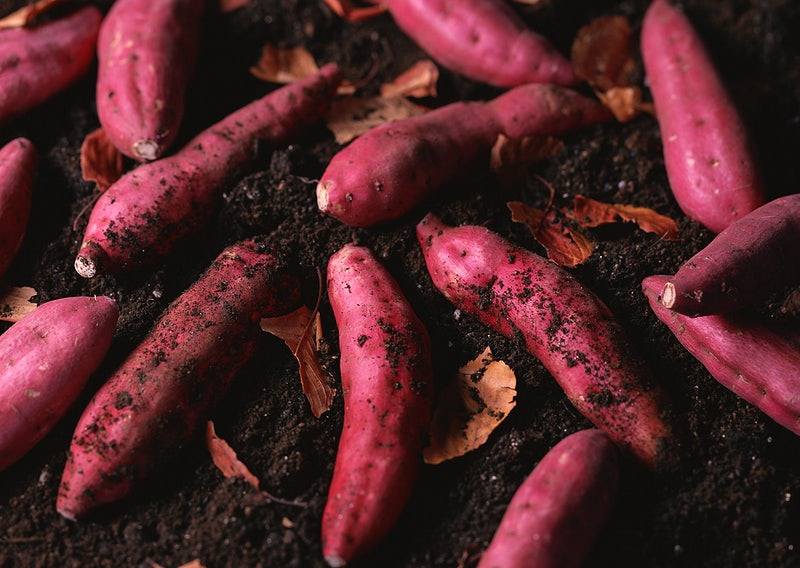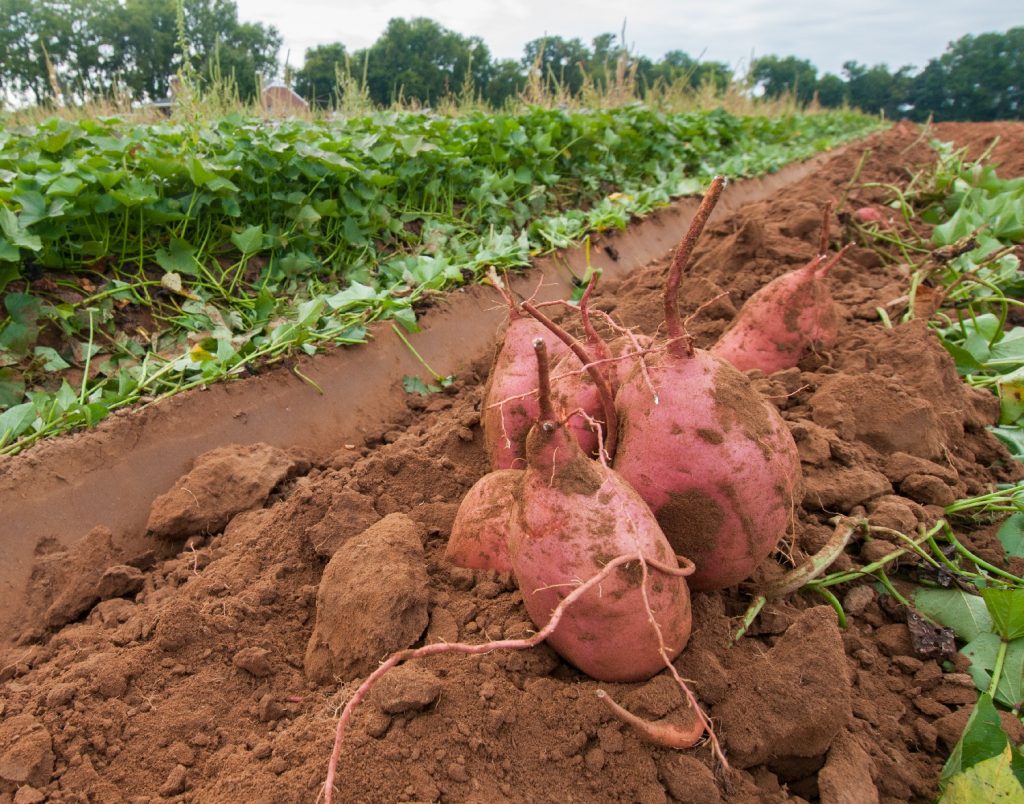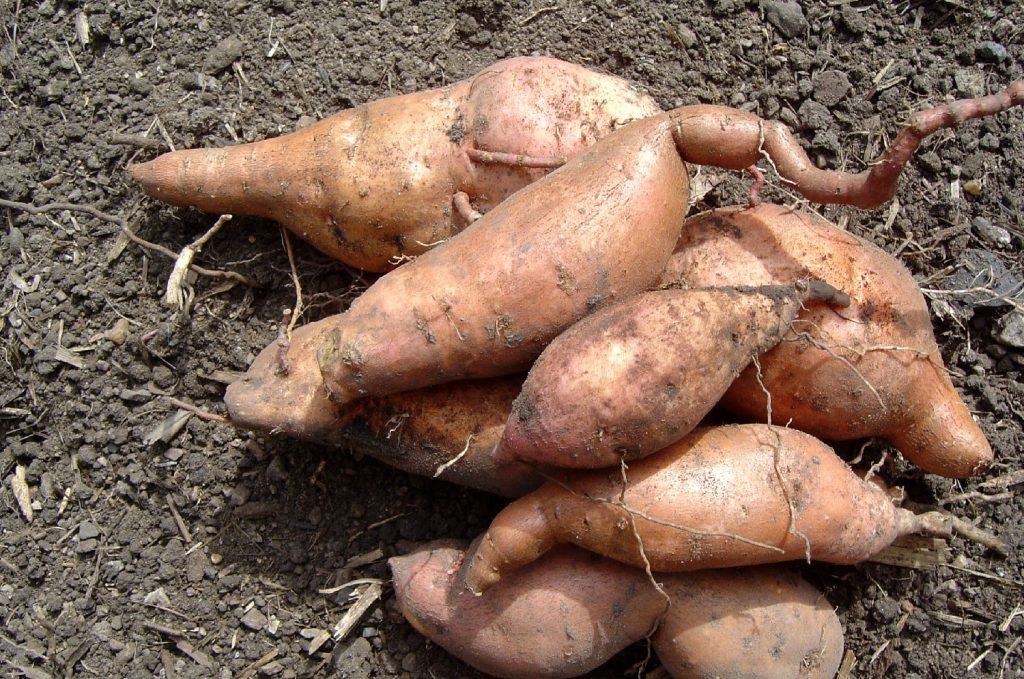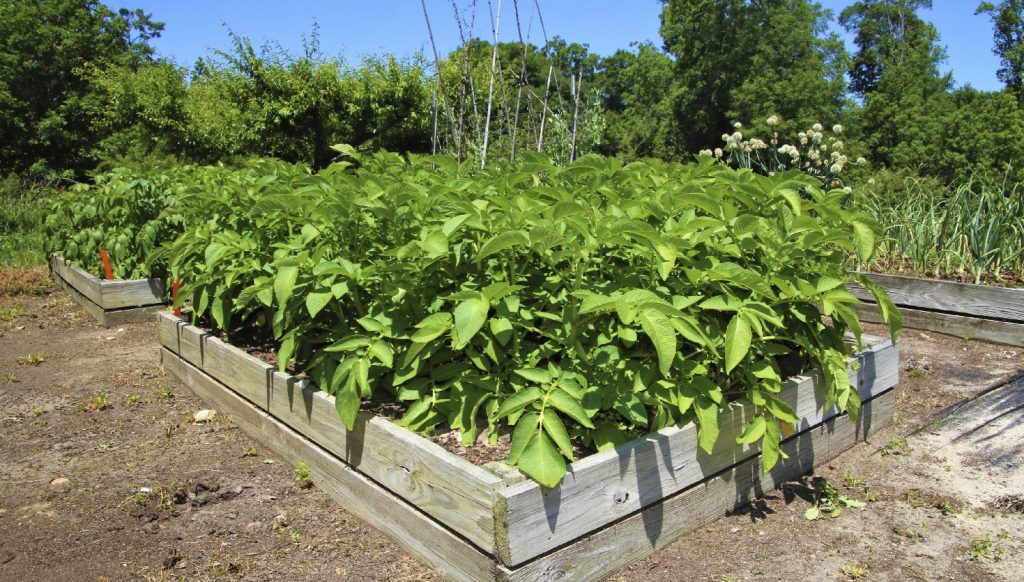

We’re here to help! Wild Yards is a completely free website that is 100% dedicated to helping you create a wildlife-friendly, sustainable yard. Read more
WildYards is reader-supported. When you buy a product through a link on our site, we may earn a comission. Every product is independently selected by our (obsessive) editors and our reviews are unbiased and objective. Read more about our mission or our privacy policy.
One of the things that often gets overlooked when planning a backyard garden is how many vegetables a single vegetable plant can produce. If you plan on making multiple sweet potato pies, but you only grow one plant, you’ll likely come up short on sweet potatoes in the kitchen. So before you start planting, it’s important to know just how many sweet potatoes per plant can grow. This will give you a better idea of how many sweet potatoes to grow in your garden.
A single sweet potato plant can produce anywhere from 5 to 10 sweet potatoes. Growing your sweet potatoes in ideal conditions will support a healthy crop. Additionally, sweet potato plants fertilized with homemade compost tend to perform better than plants whose nutritional needs go unmet.

How many sweet potatoes can you expect per plant?
First things first: how many sweet potatoes per plant will grow in your garden? The answer is 5 to 10 — that’s 4.6 to 5.5 pounds of potatoes per plant in a single growing season, which lasts around 6 months.
You’ll harvest fewer potatoes if the plants are grown in less-than-ideal conditions. Conversely, you’ll harvest more potatoes when plants are grown in ideal conditions. It’s worth noting that some sweet potato varieties produce more sweet potatoes than others. ‘Hatay’ sweet potato plants average 10 per plant, whereas ‘Kalem’ sweet potato plants average only 7 per plant.
Growing sweet potatoes in unsuitable growing conditions results in poor crop production. Supporting your sweet potato plants by giving them everything they need to thrive is by far the best way to enhance growth.
What are the sweet potato’s ideal growing conditions?
For best results, you should grow your sweet potatoes in full sun in loamy soil. The soil should be rich in organic matter because sweet potatoes are heavy nutrient users that require a lot of minerals to produce. Sweet potatoes prefer to be planted in soil that is neutral to slightly acidic with a pH of 5 to 6.5.
Sweet potatoes are root vegetables. So, like carrots, they need their soil to be loose and free of sticks, rocks, and other debris that can make it difficult for them to grow. While these plants prefer to be grown in moist soil, that soil must also drain well. Sitting in water will cause the tubers to rot, and your potato crop will take a hit as a result.
Sweet potatoes are acutely sensitive to the cold. They grow best when the temperatures are above 55 degrees Fahrenheit. Being exposed to cooler weather for prolonged periods results in stunted growth. The warmer and more humid the climate, the better your sweet potato plants will grow.

How should you start your sweet potato plants?
Sweet potatoes take quite a while to mature. These are not fast-growing plants, so be prepared to wait 100 to 170 days to harvest your crop. Because they take so long to grow, and because they don’t grow well in cold temperatures, most gardeners prefer to start their sweet potato slips indoors 4 to 6 weeks before the last frost of the season.
Begin by cutting the tubers into 2-inch sections. You can use sweet potatoes purchased from your local grocery store. Take the sections and place them cut side down in tall jars, ensuring the bottom half remains submerged in water. Be sure not to drown the slips in the water, as they will not grow if they’re completely submerged. You may need to poke several toothpicks into the sides to suspend the slips on the tops of the jars, to help keep them in a proper position.
Once you’ve got your sweet potato slips situated, place them on a sunny windowsill. Be sure to check the water level regularly. Your slips will begin to develop roots in just a few days with shoots sprouting up not long afterward.
When should you move your sweet potato plants outside?
When the shoots of your sweet potato plants reach about 4 inches tall, and when the outside temperatures remain above 55 degrees Fahrenheit, you can transfer your slips to your garden. Plant your slips 1 ½ to 2 feet apart with 3 to 4 feet in between rows, so they have plenty of room to branch out. Place the slips roughly 2 inches under the soil, being sure to leave a little bit of the stem above the ground.
Sweet potato plants need 6 to 8 hours of sunlight every day, but they also need their soil to stay moist while they grow. If the soil surrounding your sweet potato plants starts drying out too quickly, cover the area with a layer of sawdust, woodchips, or hay to help retain moisture.
Unlike most vegetables, sweet potatoes don’t like to be grown in nitrogen-rich soils. For this reason, you should avoid growing your sweet potato plants near your bean plants. Beans and other legumes enhance nitrogen availability in the soil. Growing sweet potatoes near beans will result in poor growth, meaning fewer sweet potatoes to harvest at the end of the season.

How many sweet potato plants should you grow?
How many sweet potato plants you grow depends on how much space you have in your garden and how many sweet potatoes you want to eat. If you’re growing a garden for yourself alone, 2 or 3 plants will provide you with plenty of sweet potatoes to enjoy. If you’re growing a sweet potato crop to feed a family, or if you want to share your sweet potatoes with your neighbors, you may want to grow a row of 5 to 8 plants.
Of course, if you have the space in your garden, and plenty of homemade compost to enrich the soil, you can grow as many sweet potato plants as you want. Sweet potatoes are a highly nutritious alternative to regular potatoes because they’re lower in starch than regular potatoes. They’re also an excellent source of vitamin A, as well as potassium, phosphorous, and calcium.
Can you grow sweet potatoes in raised beds?
Yes! You can grow sweet potatoes in raised beds, you can even grow them in large pots if you only have a small patio garden. As long as the containers you choose are deep enough and you can keep the plants spaced far enough apart, you can grow sweet potatoes anywhere you like.
A good rule of thumb is to grow 1 sweet potato plant per square foot. This gives each plant the root space and above-ground room it needs to grow. If growing sweet potatoes in containers, we recommend using 20-gallon buckets. Be sure to drill drainage holes in the bottoms of the buckets to allow excess water to escape.
Regardless of where you grow your sweet potato crop, it’s critical to amend the soil after the harvest. Remember, sweet potatoes are heavy nutrient users. They take a lot of nutrition out of the soil. If you don’t replenish those nutrients, any plants you grow after them will suffer.

When can you harvest your sweet potato plants?
Sweet potatoes are ready to be harvested 100 to 170 days after planting. That’s a pretty big range. So how can you tell when it’s time to dig up your sweet potatoes and get a taste of the fruits of your labor?
Sweet potatoes produce vibrant green foliage with contrasting purple stems. They’re so beautiful that they’re often grown purely as ornamentals, not for their roots. But you’ll know it’s time to harvest your sweet potatoes when the foliage begins to turn yellow.
Once you start nearing the 100-day mark, water your sweet potatoes sparingly. Stop watering the plants once the leaves begin to turn, or 2 weeks before the first frost.
How can you harvest your sweet potatoes?
Sweet potatoes have delicate skin, so they must be extracted carefully to prevent damage and bruising. To harvest your sweet potatoes, use a hand trowel to loosen the surrounding soil and carefully pry them up from the ground.
Start by using the hand trowel to cut a circle around the potato plant’s dripline. Then use the trowel to feel around in the soil and determine where the potatoes are located. This can be a time-consuming process, but the more you do it, the better you’ll get at it.
Once you’ve harvested all of your sweet potatoes, you’ll need to cure them. Allow your sweet potatoes to dry in the shade for 2 to 4 hours, then transfer them to a warm, dark, humid location that stays between 80 and 85 degrees Fahrenheit. Spread the potatoes out to allow for better air circulation, and leave them to cure for 14 days. Once cured, store your sweet potatoes in a cool, dry place.
Growing sweet potatoes: a few tips for a better crop
Even though we generally only eat the sweet potato roots, growing your sweet potatoes up a trellis gives the foliage something to latch onto so the plants don’t smother each other or any surrounding vegetables. Growing your sweet potatoes near companion plants like thyme, basil, oregano, and dill helps repel pests that can damage your crop.
If you live in a warm climate, you’ll find sweet potatoes are very easy to grow. These are hardy, disease-resistant vegetables. As long as you meet their growing requirements, you’ll have no trouble getting the most out of your sweet potato plants. Testing your soil and amending it appropriately will help you grow the best sweet potato crop possible.
